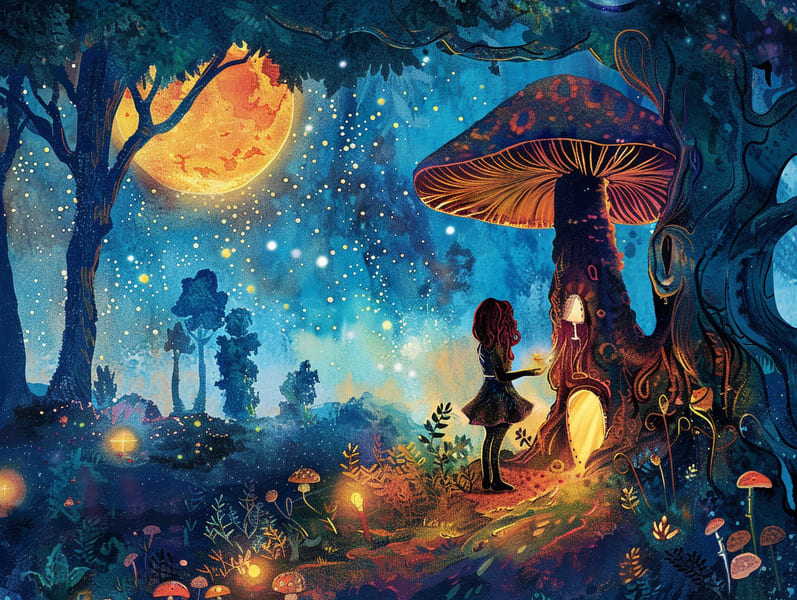
Fairy tales have historical significance. These tales have been told from one generation to the next well before they were ever transcribed. They developed from a variety of traditions, including African traditions. They were initially conveyed among adults, often carrying themes and messages reflective of the societal norms and beliefs of the time.
Jacob and Wilhelm Grimm, Jacob and Wilhelm Grimm, were among the first to collect many of these beloved stories. Their compilation, "Grimm's Children's Stories," included narratives like "The Little Glass Slipper," "Hansel and Gretel," and "The True Story of Snow White," which have since become mainstays in the world of timeless fairy tales. Similarly, Andersen's imaginative narratives, such as "The Mermaid," and "The Little Duckling," have floated into hearts worldwide, establishing their place in the pantheon of timeless fairy tales.
Despite being ancient, these stories remain as pertinent as ever, especially as nighttime stories for kids. These whimsical stories are now available in different formats, including beautifully illustrated books, magical animations, and online fairy tales.
Their lasting presence can be traced to several whimsical characteristics:
Key Lessons: Old fairy tales often impart important moral lessons. Narratives like "The Tale of the Boy Who Cried Wolf" teach the virtue of being truthful, while "The Race of the Tortoise and the Hare" underline the values of tenacity and humility. These narratives offer children clear distinctions between ethical and unethical, helping to shape their moral compass in a mild yet profound way.
Empathy and Understanding: Traditional fairy tales frequently depict figures facing problems and hurdles, encouraging readers to understand with their struggles and back their triumphs. For instance, "The Story of Beauty and the Beast" teaches us the virtue of looking beyond appearances to see the inner being of a individual, cultivating warmth and knowledge.
Cultural Recognition: Many traditional fairy tales are interwoven with the cultural contexts from which they blossomed. Delving into these fairy tales can provide enlightening views into different customs, enhancing a sense of global insight and discernment.
Creativity and Imagination: The fantasy-filled elements in fairy tales—supernatural elements—enhance children’s fantasies. These stories transport readers to magical realms, encouraging fantasy ideas and a sense of mystery that here remains a lifetime.
Ancient fairy tales are not only whimsical but also didactic. They provide entrancing tools in developing various cognitive and emotional skills in children. When fairy tales are told out loud, they boost speech development by presenting new terms and meanings and sophisticated sentence structures. This practice also improves auditory perception and attention span, as young ones follow the story, anxious to see what happens next.
Furthermore, discussing the themes and characters of fairy tales can sharpen thought processes and reasoning skills. Young ones are instructed to identify patterns, expect results, and catch on to cause and effect. These explorations also advance young ones communicate their thoughts and feelings, nurturing their emotional intelligence.
In today’s information age, the availability of online fairy tales has made these stories more obtainable than ever. Digital sites and online apps present large libraries of famous fairy tales that can be read or listened on anytime, anywhere. Fairy tales voiced are particularly popular, extending an delightful method for children to enjoy these alluring stories. Voice books and read-to-me videos lead characters and settings to life, often complemented by magical melodies and instrumentals that improve the story adventure.
The lasting appeal of ancient fairy tales lies in their ability to transform to present eras while sustaining their basic principles. Contemporary retellings of these fairy tales often incorporate more different protagonists and modern settings, making them relatable to today’s audience. However, the main ideas of boldness, understanding, and justice remain unchanged, continuing to touch readers of all ages.
Old fairy tales also offer a sense of reassurance and familiarity. They render accessible a well-arranged narrative with a straightforward beginning, middle, and end, often ending with the culmination of conflicts and the triumph of right over wrong. This predictability can be comforting for young ones, furnishing a sense of security in an constantly changing world.
Traditional fairy tales continue to spellbind and train new generations, maintaining their elegance and importance in modern society. As bedtime stories for kids, they put forth a perfect blend of fantasy and learning, boosting moral values, empathy, and creativity. The prevalence of online storybooks and the prevalence of fairy tales told out loud ensure that these old fairy tales remain acquirable to new generations.
By retaining and communicating these tales, we continue to celebrate the rich tapestry of narrative artistry and cultural heritage. Whether you are perusing a vibrantly illustrated book, viewing a web-based library, or hearing an spoken story, the attraction of Grimm's fairy tales is always within reach. These fairy tales point out of the eternal essence of fairy tales and its ability to link us across eras and regions.
If you are delving into a vividly illustrated book, enjoying a virtual library, or playing an spoken story, the magic of traditional fairy tales is always within reach.
These stories convey of the unfading magic of stories and its ability to bond us across epochs and places, creating a bond that delights and instructs alike.